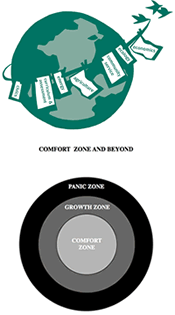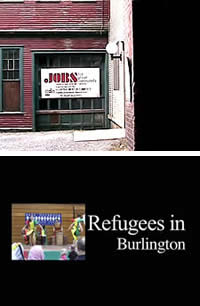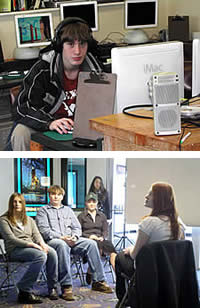
CABOT, VT— Charles Russell, a Vermont farmer, remembers when he told his dad he wanted to grow up and be a farmer with 20 acres. His father quipped, “What you gonna grow, rocks?”
Russell is one of a handful of scrappy organic farmers featured in “Farmers Have a Say,” a documentary video produced by students at Cabot Middle School, here in the Green Mountain State.
Turns out Russell’s dad was half right, the students learned. Russell has made a good go of organic farming, but it’s been a rocky path. When the students’ video premiered at a packed public meeting, one student told the audience, “I learned that farmers do the work they do because they like to, not to make money.”
Like farming, videography is persistent, slow, and steady work, these young filmmakers have also found in the past year. In eight Vermont towns, students and teachers have been recording stories from their communities as part of a statewide project called “Lights, Camera . . . Leadership!” (LCL), developed with the Orton Family Foundation and the Vermont Rural Partnership.
The young documentary-makers use primary sources to study an issue from past, present, and future perspectives. Next, they create a video synthesizing their findings. Finally, they organize and host a community premiere followed by student-led discussion groups.
A complete curriculum
The LCL curriculum involves more than learning how to create documentary video, however. For teachers, it requires that they make their pedagogy more student-centered. For students, it demands that they try new skills and roles, interview people they do not know, connect with adults in the community, practice teamwork, and mobilize others to care as much as they do about the topic at hand. From the state’s point of view, the curriculum must also meet Vermont’s educational standards.
Indeed, making a “full value commitment” to the LCL project is one of the first items asked of students and teachers. Expectations are high: behaving collaboratively, valuing compromise, working on deadline, taking risks, staying organized, revising work so that it is worthy of pubic exhibition. According to one student, having “faith in other people’s skills” was an unexpected challenge.
A Vermont Department of Education grant also required that participating schools integrate LCL into the academic core, rather than treat it as an “add-on.” A content teacher and a technology-savvy partner from each site attended a graduate-level course to help them navigate the complexities of such a multidisciplinary undertaking. Schools also agreed to take part in a thorough evaluation of the project by the University of Vermont.
A diverse group of sites and topics
The eight sites include three middle schools, four high schools, and one alternative school in seven rural Vermont towns and the comparatively larger South Burlington. One school incorporated LCL into a U.S. Constitution middle school unit, another wove it into a multidisciplinary language arts/social studies course, and a third made it part of a media literacy class.  One middle school used the curriculum as the basis of its advisory program, providing direction and purpose to this time teachers and students spend together. The alternative school employed LCL as an after-school, credit-bearing option.
One middle school used the curriculum as the basis of its advisory program, providing direction and purpose to this time teachers and students spend together. The alternative school employed LCL as an after-school, credit-bearing option.
The topics students chose to study were as diverse as the schools themselves. Choosing topics, in some instances, required skillful negotiation. As one student said, “I learned how getting the majority of a group to agree on something takes awhile.”
The students in Springfield, Vermont decided to focus on the abandoned factories in their town. Their film, “Broken Buildings: New Beginnings,”urges town planners to renovate the factories as part of their community’s renewal. Students in Twinfield documented a new exchange with students in Bogalusa, Mississippi, forged when Twinfield students sent a truckload of Vermont timber to Bogalusa after Hurricane Katrina. With a growing refugee population in Burlington, students there placed their focus on the needs and acceptance of local refugees.
Eighth graders in Charleston chose to look beyond their local community, asking “Who has the power in our country to declare war and to keep us at war?" Their powerful video, “A Look through Others’ Eyes: The True Colors of War,” makes a compelling case for alternative ways to resolve the world’s conflicts. “When the students said they wanted to do this topic,” their teacher recalls, “I first said, you know guys, do you really want to do this? I was thinking about myself—I mean, [our town] is pretty conservative. [In the end] I think [the students’] analysis was respected by the community. I don’t think anyone could argue against looking into alternatives to war or the horrors of war.”
What did students learn?
 In the documentary process, students learned much about their subject matter. “I learned how much about war is kept a secret,” wrote one. Working on a video about perceptions of cafeteria workers, one student said, he learned that “there is more to the lunch than just food.” Another noted, “I did not know the difference between a refugee and an immigrant. Now I do.”
In the documentary process, students learned much about their subject matter. “I learned how much about war is kept a secret,” wrote one. Working on a video about perceptions of cafeteria workers, one student said, he learned that “there is more to the lunch than just food.” Another noted, “I did not know the difference between a refugee and an immigrant. Now I do.”
Students gained insight into media literacy, too. “We learned that we could edit our video to make the farmers seem like they said something that they did not mean,” said one of the Cabot students behind “Farmers Have a Say.”
They learned that others would listen to their voices. Many had doubted the public impact of their work, worrying they would be perceived as childish. “We thought that the community thought that we’re not mature enough to have a good outlook on our town, that we were just a bunch of immature kids,” noted one student. “We think we proved them wrong.”
Students also learned essential interpersonal and leadership skills, in addition to becoming competent videographers. “[O]ur students have walked away from this project with asset skills that they needed to develop to be successful in life,” says Sharon Gonyaw, an 8th grade guidance counselor from Charlestown Elementary. “They are better communicators, [have] developed better reasoning and problemsolving skills to deal with issues that arise, have been empowered to believe in themselves, and have connected themselves closer to their community. Most importantly, they have been given a voice; they know that their opinions and ideas matter and that they can make a difference.”
What did teachers learn?
Teachers saw at once that the videography project could help them to create a more collaborative learning environment. One teacher said that her default method was to “read, study, and listen to the teacher,” even though such tactics discourage student-centered learning. “The hardest thing for me was stepping back,” wrote another. “Lulls make me nervous. I’m glad I broke through that barrier.” A third teacher said, “This has made me more conscious of what I want to be doing as a teacher. I’d like to move beyond the adversarial role. They see you as forcing them to do something. This was about sharing the learning. I felt more like a facilitator in this project.”
The collegiality of having a teaching partner also helped teachers break old habits. “It really helped to keep me focused on the right things (in this instance, giving the kids the authority),” one observed.
A number of teachers now plan to integrate technology into future class work. “This experience is broadening my identity as a teacher,” said one. “My focus as an educator has been narrow, as I typically only focus on science. Now that I have completed this project, I am much more amped up, not only to utilize video in my classroom, but also to take on more extracurricular video projects."
Adding it all up
Community members responded with enthusiasm to the local premieres. The students seemed to have extraordinary appreciation of the project, one commented: “They were in this with all their heart, their love of their town comes through.” Another noted that the students had been given “adult realities” to which they responded with maturity and dignity: “A ‘weighty’ topic for this age and especially well done!”
A survey showed that 46 percent of community members felt “more positively about looking to youth as community leaders after having attended the premiere.” One comment made the bottom line especially clear: “We need more of this sort of school work!”
In their documentary about small farmers, Cabot students showed farmer Bill Half asserting that large commercial growers and corporations “don’t have the same values of giving back to the community.” As these Vermont students and teachers turn over every rock to look closely at their own communities, they, too, have brought a new kind of satisfaction to their educational harvest.
Note: Most of the student, teacher, and community quotes in this article come from a recent project evaluation conducted by Christopher Koliba, Ph.D., University of Vermont.




